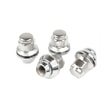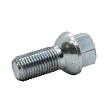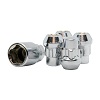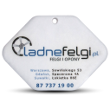How does the car wrapping service work? How much does a car wrap cost? – Overview of prices and their components Car wrapping: advantages and disadvantages How long does it take to wrap a car? – Service completion time Frequently asked questions about car wrapping Source: Freepik
How does the car wrapping service work? Car wrapping is a process that requires not only specialized materials but also precision and experience. To ensure a flawless and durable car wrap, every step must be performed with the utmost care – from vehicle preparation to fine-tuning the details.
Preparing your car for wrapping – the key to success Every car wrapping process begins with meticulous vehicle preparation. First, the car is thoroughly washed, removing road grime, asphalt deposits, wax residue, and any contaminants that could impede the film's adhesion. Next, the bodywork is degreased using specialized agents to ensure the film adheres perfectly to the paintwork.
In many cases, elements such as mirrors, door handles, and decorative trim are also removed. This allows the wrap to be applied in one piece, without visible gaps or creases, resulting in a more aesthetically pleasing result. It's also crucial to remove any paint imperfections —even minor scratches or chips can be visible under the wrap and affect its durability. Therefore, car preparation is the foundation of the entire process and key to a professional-looking car wrap.
Foil selection and application technique Once the car is prepared, it's time to choose the right film and application technique . Car wraps are available in various variants, and the choice depends on the desired effect and the client's budget. Cast films are among the most popular, offering the highest flexibility and durability – they're perfect for completely changing a car's color and adapting to even the most complex body shapes. A less expensive alternative is polymer films , more often used for smaller projects or short-term purposes, such as advertising.
The film application technique is also crucial. There are two basic methods: wet and dry . The former facilitates film positioning and allows for adjustments during application, while the latter requires more experience but provides exceptionally long-lasting results. Regardless of the technique chosen, specialized tools and a skilled applicator are essential, as precision in the application determines whether the car wrap will look perfect.
Finishing and details – attention to perfection Once the film is applied, it's time for finishing touches. These are crucial to the final result and the durability of the entire process. Specialists precisely cut the material, secure the edges, and heat the film to ensure it holds its shape and doesn't peel over time. At this stage, every detail counts – even the smallest imperfection can significantly impact the car's appearance .
The finishing touch also involves thorough quality control: ensuring there are no air bubbles under the wrap , ensuring all elements are evenly applied , and ensuring the overall aesthetic appeal. This ensures the car owner receives a result that not only pleases the eye but also provides long-term paint protection. Car wrapping is an art in which attention to detail is crucial, so it's best to entrust this service to experienced professionals.
How much does a car wrap cost? – Overview of prices and their components The price of car wrapping is a topic that generates the most interest among drivers considering changing the appearance of their cars. Contrary to popular belief, there's no single, universal price – the final cost depends on a number of factors, such as the type of wrap , the size and type of vehicle , the scope of work , and the experience of the workshop . It's important to understand the price breakdown to make an informed decision about the desired effect and how much you're willing to spend.
The type and quality of foil – the biggest determinant of price Types of foil – comparison in one place Type of foil Characteristic Flexible, adapts to complex shapes Less flexible, shorter durability Colorless, thick, protects the paintwork Durability 7–10 years 3–5 years 5–10 years Application Color change, special effects Advertising, short-term projects Paint protection against scratches and chips Price (higher)
(cheaper)
(the most expensive)
The most important factor influencing the cost of a car wrap is the choice of film . Its quality determines both the visual effect and the durability of the entire investment. Products from renowned brands such as 3M , Avery Dennison , and Oracal are available on the market, guaranteeing high resistance to UV radiation , weather conditions , and everyday use . These films are more expensive, but they ensure the color will remain beautiful for years. The alternative is cheaper alternatives, which are temptingly priced but often fade faster and are more susceptible to damage .
The type of film finish also significantly impacts the price. Standard matte or glossy options are relatively affordable, while satin , textured (e.g., carbon, brushed) , and striking finishes like chameleon or chrome are significantly more expensive. Also worth mentioning are PPF (Paint Protection Film) protective films , which don't change the car's color but act as a "shield" against scratches and stone chips. This is the most expensive option on the market, but also the most effective in protecting the paint.
Vehicle size and type – the larger, the more expensive The type of vehicle you have is also important. Wrapping a small city car will be significantly cheaper than working on a large SUV, van, or delivery van. The price increases proportionally to the body's surface area, but also to its complexity. Vehicles with numerous embossed areas, sharp styling lines, or heavily contoured bumpers require more work and precision from the applicator, which naturally translates to a higher rate. In practice, this means that two similarly sized cars may differ in price due to the body's shape.
Scope of wrapping – the entire car or just details? Not everyone opts for a complete car wrap. Partial changes to a vehicle's appearance are also popular – for example, wrapping only the roof, hood, mirrors, or selected interior elements with foil. Many people also opt for dechroming , which involves wrapping chrome trim in black, giving the car a sportier and more modern look. Naturally, such solutions are significantly less expensive than a complete paint change, and the visual effect can still be spectacular.
It's also important whether the wrapping is performed with or without disassembly. Disassembly increases the cost of the service and extends the turnaround time , but it allows for a more natural and aesthetically pleasing effect – the foil is hidden deeper , and the risk of edges peeling is significantly reduced .
Paint condition and vehicle preparation Another factor influencing the cost is the condition of the paint. If the car requires additional preparation, the price automatically increases. This may include removing the old film , polishing the surface , or making minor paintwork repairs . Professional bodyshops always pay attention to this, as perfectly prepared paint guarantees that the film will adhere well and retain its properties for a long time .
Reputation and experience of the applying company Last, but certainly not least, is the choice of contractor. The price of a car wrap service depends largely on the workshop's reputation, the experience of its employees, and the location. A studio operating in a large city and specializing in this type of service may charge higher rates than a smaller workshop, but in return, it offers a quality guarantee, the use of certified films, and full after-sales support. For many customers, these are key elements – it's better to pay a little more and have the peace of mind of knowing the car wrap was done to the highest standard than to risk rework after a poorly done job.
Approximate prices for car wrapping Scope of service Price range (net) Additional notes Wrapping the entire small/city car 2,500 – 4,000 PLN Polymer foils; simple bodywork Compact car / Sedan 3,500 – 6,000 PLN Matte/gloss; moderate complexity Premium/sports cars 5,000 – 8,000 PLN More embossing, complex bumpers SUV and vans 7,000 – 10,000 PLN Large surface area, greater workload Special foils (carbon, brushed, chameleon, chrome) 9,000 – 15,000 PLN Premium effect, higher material cost Partial wrapping (hood, roof, mirrors, dechroming) 500 – 2,500 PLN Quick personalization of selected elements PPF protective films (whole car) 10,000 – 15,000 PLN Maximum protection, no color change PPF protective films (individual elements) from 300 PLN Headlights, sills, hood – price depends on the surface
Prices are approximate. Final pricing depends on the type of wrap, paint condition, body shape, and scope of service.
Car wrapping: advantages and disadvantages When deciding to change the appearance of their car, many drivers face a choice: traditional painting or modern car wrapping . Both methods have their strengths and weaknesses, but car wrapping is becoming increasingly popular due to its flexibility and customization options. However, it's worth carefully examining the advantages and limitations of this solution to make an informed decision.
Benefits of wrapping – flexibility and protection The biggest advantage of wrapping over painting is its reversibility . With car wrap, you can completely change the color of your vehicle in a short time, and if necessary, restore it to its factory condition. This is especially valuable for new car owners who want to change the appearance of their vehicle without losing its market value.
The film also serves a protective function . It protects the original paintwork from minor scratches, stone chips, and harmful UV radiation. This helps the bodywork maintain its fresh appearance longer, and makes the car more attractive to buyers upon resale.
Another huge advantage is the possibility of personalization. Car wrapping offers access to a wide range of colors and finishes – from classic matte and gloss finishes, through satin, to structural films like carbon or brushed. Effect films are also available, such as chameleon or chrome, which allow for a unique look that is impossible to achieve with traditional paint.
Many drivers also find the film's protection of the factory paintwork a plus, which can increase the vehicle's residual value. The intact original paint is a huge plus when selling a car – potential buyers can be assured that the car hasn't undergone any bodywork or paintwork repairs.
Potential disadvantages and limitations Despite its many advantages, car wrapping isn't without its drawbacks. First, the costs can be high, especially if you choose specialized wraps with unique visual effects. In some cases, a full car wrap can be more expensive than a simple paint job.
Another limitation is the durability of the film. While the best products can last up to 7–10 years, in practice, much depends on operating conditions and care. Intensive automatic washing or exposure to sunlight can shorten the material's lifespan.
It's also important to remember that unprofessional removal of the film can damage the original paintwork . Therefore, it's crucial that the service be performed by experienced professionals using the proper tools and techniques.
Additionally, a car covered in film requires more gentle care. Hand washing with mild detergents and avoiding harsh chemicals is recommended. For some drivers, this may be a challenge in everyday use.
In summary, car wrapping is a modern and highly practical solution that offers a wide range of aesthetic possibilities and provides paint protection. However, it's worth considering the costs and the need for proper maintenance to fully utilize this technology's potential.
How long does it take to wrap a car? – Service completion time A heat gun is an essential tool when wrapping a car – it is best to choose a model with the ability to adjust the air temperature.
Wrapping a car with foil is a process that requires precision and time. Contrary to appearances, it's not a quick service that can be completed "on the spot," as each step—from body preparation, through foil application, to finishing the details—requires precision and patience. The duration depends on many factors, which are worth understanding so as not to be surprised by your car being in the workshop for several days.
Factors influencing the duration of service The first factor that determines the length of the entire process is the size and type of vehicle . Naturally, wrapping a small city car takes less time than a large SUV, van, or sports car with complex shapes. Another factor is the complexity of the bodywork – the more embossments, nooks, and details, the more time is required for careful application of the wrap.
The extent of component removal also plays a significant role. Professional car wrapping often involves removing mirrors, door handles, moldings, and bumpers to ensure the film is perfectly aligned and doesn't peel off at the edges. While this approach lengthens the process, it significantly improves the quality and durability of the service.
The type of film used also matters. Standard color films are quicker to apply, while PPF protective films are thicker and more difficult to apply, automatically extending the application time. Ultimately, experience and the number of people working on the project also play a role – in a professional studio, a team of applicators can speed up the process while maintaining the highest quality.
It's worth remembering that additional services, such as dechroming , window tinting , or PPF application to selected elements, also extend the turnaround time. Therefore, it's best to approach each project individually and consider all the details of the order.
Approximate timeframe – from a few days to a week The average duration of a car wrapping service is 2 to 7 business days , depending on the size of the car and the scope of work.
Small city cars – full wrapping usually takes about 2-3 days. Compact cars, sedans and Kombi – work usually takes 3–5 days. SUV, sports and premium cars – this time may extend up to a week due to the large surface area and complex styling. Partial wrapping (e.g. bonnet, roof, mirrors) – in many cases, this can be done in 1 day. It's worth noting that workshops often schedule turnaround times individually. It all depends on material availability, studio capacity, and any additional preparatory work that needs to be done on the paintwork. Therefore, it's best to schedule a date in advance and thoroughly discuss the scope of the service with the contractor.
Frequently asked questions about car wrapping Is car wrapping legal?
Yes, car wrapping is completely legal, as long as the film doesn't alter the vehicle's safety parameters (e.g., it doesn't darken the windows beyond legal limits) and doesn't violate road traffic regulations. It's important that the film is homologated and applied correctly.
Does car wrapping affect the manufacturer's warranty?
Simply covering a car with a wrap typically doesn't void the manufacturer's warranty. However, this may depend on the terms of the specific warranty – it's worth checking with your dealership. If the installation is done unprofessionally and causes paint damage, the manufacturer may refuse to perform warranty repairs in this area.
How long does car foil last?
The durability of a wrap depends on its type and quality. Standard car paint change wraps last approximately 3–5 years, while PPF protective wraps last up to 7–10 years. Proper car wrapping and subsequent maintenance are also important.
Can a wrapped car be washed in an automatic car wash?
It's possible, but not recommended. Automatic car wash brushes can damage the edges of the wrap. Hand washing or a touchless car wash is the best option. This will help your car wrap retain its aesthetic appeal for longer.
Does the wrap hide scratches and dents?
The film effectively covers minor scratches and paint imperfections, but it won't remove larger dents or dings. Before wrapping your car, it's best to repair any major imperfections to ensure a flawless finish.
Can I wrap my car myself?
Theoretically, yes, but car wrapping is a process that requires experience, specialized tools, and specific conditions. Trying to do it yourself often results in air bubbles or poorly fitting wrap. Professional installation ensures aesthetics and durability.
Is removing the foil difficult?
Professionally applied, high-quality film is relatively easy to remove and shouldn't damage the paint. However, the process requires heat and precision. Removing old or cheap films can be time-consuming.
Do I need to change my registration certificate after applying the sticker?
Yes, if the color change is significant (e.g., from black to white), you must report it to the Department of Motor Vehicles and make a note in your vehicle registration document. Partial vehicle wraps (e.g., hood or roof) usually don't require this.

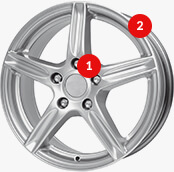

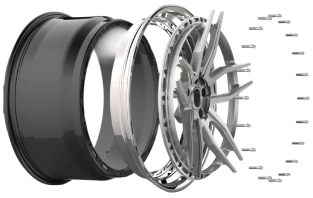
 Modern design
Modern design Perfect fit
Perfect fit High durability
High durability Free shipping within 24 hours
Free shipping within 24 hours
 Individual project
Individual project Dedicated caregiver
Dedicated caregiver
